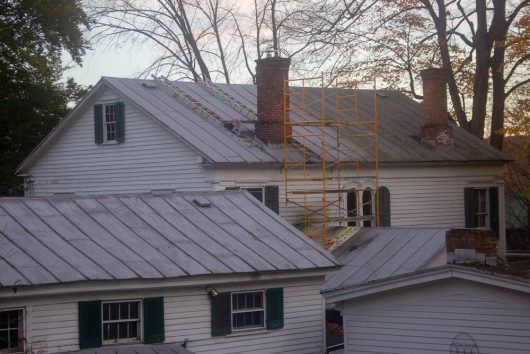 Another day, another project. Recent heavy rains revealed a leak in our dining room ceiling. The culprit? A 19th-century chimney. According to the mason we hired, the chimney is peppered with cracks and holes. Too many holes, in fact, for a mere repointing-job. To banish the drip, the chimney must be rebuilt. And what a fun job that will be. Pictures, details, and a tour of the dining room:
Another day, another project. Recent heavy rains revealed a leak in our dining room ceiling. The culprit? A 19th-century chimney. According to the mason we hired, the chimney is peppered with cracks and holes. Too many holes, in fact, for a mere repointing-job. To banish the drip, the chimney must be rebuilt. And what a fun job that will be. Pictures, details, and a tour of the dining room:
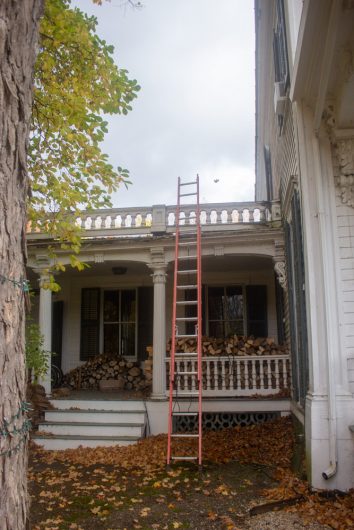 Accessing the chimney is no easy feat. First, the mason placed a ladder in front of the dining room porch. (The dining room is an 1835 addition to this 1826 house. It has its own roof.)
Accessing the chimney is no easy feat. First, the mason placed a ladder in front of the dining room porch. (The dining room is an 1835 addition to this 1826 house. It has its own roof.)
 Then he arranged scaffolding over the dining room roof in order to reach the (much higher) main roof. My palms sweated as I watched the mason climb this stairway to heaven. Are you acrophobic too?
Then he arranged scaffolding over the dining room roof in order to reach the (much higher) main roof. My palms sweated as I watched the mason climb this stairway to heaven. Are you acrophobic too?
 Good news: When Mr. Mason reached his destination, he filmed a video of the chimney so that I (and you!) could see the chimney’s deteriorated back side. Bad news: I don’t know how to transfer the video from my cell phone to this website. So a screen grab must suffice.
Good news: When Mr. Mason reached his destination, he filmed a video of the chimney so that I (and you!) could see the chimney’s deteriorated back side. Bad news: I don’t know how to transfer the video from my cell phone to this website. So a screen grab must suffice.
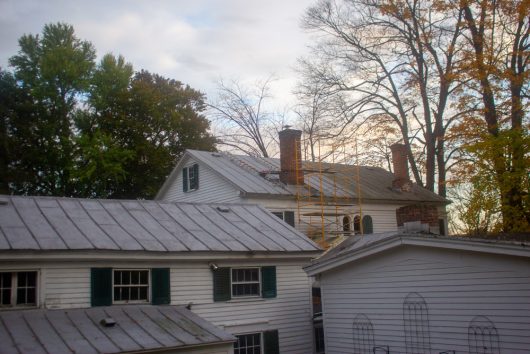 The tear-down and rebuild will commence one week from today. I’ll post an update! xKevin
The tear-down and rebuild will commence one week from today. I’ll post an update! xKevin
P.S.: Here’s a video tour of the dining room. To watch, just hit the play arrow.
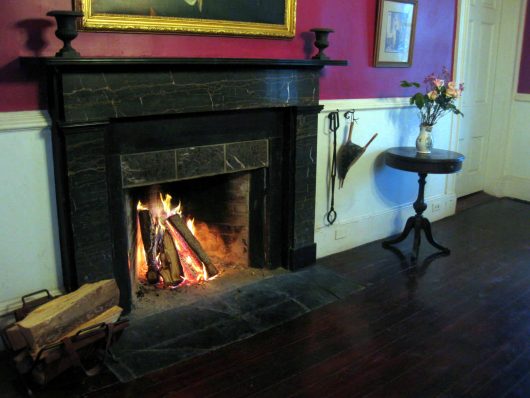 P.P.S.: The chimney is not a fire hazard. It’s equipped with a stainless steel liner that runs from the fireplace below all the way up to the top of the chimney. I have the liner professionally cleaned each year.
P.P.S.: The chimney is not a fire hazard. It’s equipped with a stainless steel liner that runs from the fireplace below all the way up to the top of the chimney. I have the liner professionally cleaned each year.
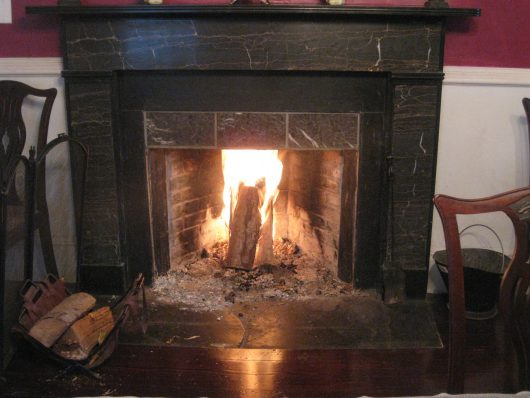 P.P.P.S.: I’m beginning to doubt the mason. Why? Because the fireplace remains dry no matter how fierce the rain. Does this suggest to you that the source of the leak is NOT the chimney?
P.P.P.S.: I’m beginning to doubt the mason. Why? Because the fireplace remains dry no matter how fierce the rain. Does this suggest to you that the source of the leak is NOT the chimney?
 A
A penny martini for your thoughts!
Everybody’s doing it: Get my email updates!

Kay says
He could be right. It could be leaking between the bricks and the liner and then following the rafters to where it’s coming through the ceiling. Maybe a roofer is needed for a second opinion?
Lori says
Hi Kevin!
It is of the utmost importance that your mason uses historic mortar when doing the rebuild. I have personally found the information on the Edison Coatings website and the information on the Rosendale natural cement products to be most helpful in understanding the intricacies of this particular subject matter. The idea is that the mortar must be soft enough so as not to “crush” your brick. Modern day cement is the go to for most masons and more often than not they wind up creating more problems if they use the wrong mortar (to high of a PSI relative to the softness of the historic brick).
Having said that, I am not 100% convinced that your leak is caused by the brick issue. More likely than not your problem may be in the roof flashing. In particular — the flashing surrounding the chimney itself and the flashing where the dining room roof meets the adjacent structure. I have a 1914 home with a steep roof and numerous dormers and thusly have become a bit of a flashing expert by my own right! My home is a “baby” compared to yours. In any event, inadequate or improperly installed flashing where roof lines meet vertical sections (such as a chimney or adjacent wall) is usually the culprit in most leaky roof situations and is the cause that is most frequently overlooked. They have specialized membranes that when used in conjunction with the metal flashing and other sealers create leak proof “joints”. I have seen historic metal roofs torn off and replaced for no good reason when the issue is and always was the flashing and/or a situation that could have been easily corrected with the application of a proper metal coating or patch.
I personally restored 36 multi paned original wood windows in our home and suffice to say that I will not have a future as a hand model. I saved them all — reglazed each and every one of them, scraped, sanded, repaired. It was not an easy job but fundamentally I had no choice — I could not find someone to do the work — so I took the job on myself. It is gratifying when people would stop by and ask me if I was out for hire! Of course, my answer was “NO”.
In closing, I would like to tell you how very much I enjoy your blog. You are such a totally sweet person, Kevin. You come across as being so kind hearted and without any pretense. I just love the way you communicate — it is warm and genuine. Godspeed and thanks for being a bright shining light in this world!
Kevin Lee Jacobs says
Hi Kay – Good news: a roofer is stopping by this week.
Hi Lori – Thank you for the great advice re: mortar, flashing, and ice-and-water shield. Kudos to you for restoring all those multi-paned windows. What a job!!!
Dorothy says
Kevin, I have to agree with the previous person. I am in a 1935 house and several years ago had the chimney rebuilt and had exactly the same problem after. Water was running out the clean-out on the second floor and also it ran into a bedroom ceiling on the second floor and the livingroom on first floor near where the chimney is. Had someone put some ‘tar’ (for chimneys – not sure of the exact name) on the side where it was leaking and never had a problem since. Of course the best thing to do is replace the flashing which I will do in the near future. It is worth a try and perhaps only leaks when the rain/wind come from a certain direction, eg. westerly. It only leaked maybe twice a year but that is enough to do damage.
Helen says
It may only leak inside when the wind blows strongly or in a certain direction. That happened with a leak in the flashing of my chimney.
Susan says
Hi Kevin and Mr Fox,
I live in Derbyshire, UK in a traditional property only a few years younger than your magnificent home.
I am flattered that you enjoy your restoration to make a very classy and elegant property , just so English and Stately
Susan Iseman says
We had a similar issue (no water in the fireplace) and discovered that water had leaked into our attic, causing mold behind some old sheetrock. It required remediation and we had to toss many boxes of stuff and replace them with plastic bins. I would check your attic or any crawl spaces if you have them. Water goes where it wants, not always where you think !
Cary Bradley says
Hi Kevin!
I am so sorry for your leak and need for challenging repair. Glad to hear a roofer is coming by also. We put skylights in our little beach cottage and despite my worries, they never leaked u til we had the roof redone. Then they leaked until we reinstalled them again ourselves with new flashing kit. Wishing you the very best with this tough nut. It is certainly gorgeous out Ho. Cheers!
Morgan says
Sorry that’s happening, Kevin. I hope the work goes well.
Since you mentioned it, here’s a fabulous tribute performance of Stairway to Heaven by Heart. ❤️ https://youtu.be/LFxOaDeJmXk
Peg says
Hi Kevin —
I live in an 1830s brick house and don’t even get me started on contractors! lol. We couldn’t find any reasonable masons in our area so we’ve had to learn to do re-pointing ourselves. It’s actually surprisingly easy, just slow work if you’re paying someone by the hour.
I agree with the other posters — check out the chimney flashing and roof flashing first. Because even a leak into the chimney would go where ? Down the chimney and then since it can’t get into your liner — the water would start to pool around the base of the liner and then overflow into…?
Chimney itself looks fine to me — I don’t see any holes there at all, certainly not anything bad enough to warrant a tear down. Masons always want to tear down and start over because re-pointing is a major PIA, and not as lucrative. Check out the website of LimeWorks US for all you ever wanted to know about historic brick and stone repair. Is the mason going to reuse those old clay bricks and use lime mortar, or is he going to rebuild using ugly modern cement bricks and concrete? It will look ugly sitting up there if it’s not done right.
Anyway — good luck!
Arthur in the Garden! says
Ahh, yes the joys of owning an older home. My 1950s also had a chimney separating from the roof. As foundations heave and ho things settle.
Linda says
I agree with the flashing idea. My main concern is not with the leak (I think you’ll get that solved pretty quickly), but with the firewood stored on the porch. You need to move it away from the house pronto. Firewood attracts termites and sundry other creepy crawlies and you DON’T want to provide them with easy access to your walls.
Joan Dreyer says
Lori is on the right track. Chimneys need to be flashed with metal to divert the rain and snow away from the joining of brick to roof. Roofers who understand historic structures will sometimes build a saddle on the top side of the chimney to divert water around the chimney. As a retired remodeling contractor on historic homes, we would find that a roofer has previously removed the saddle. They thought just tarring around the chimney was good enough. not! Let us know what your roofer says. We love your house. You and Mr. Fox give it so much tender care.
Mary C says
ALWAYS check flashing first! Glad a roofer is adding two cents!
Patricia A. Holmes says
Not a roofing/chimney expert but must thank you for your comments regarding your acrophobia. I have lived with that for 83 years and counting. The dizziness, weak knees, and other physical sensations that accompany it are totally out of your control. Hiking up mountain trails never bothered me but there was no way I could go anywhere near the edge. So to you and to all the others out there with this mild but ever present “diagnosis”…stay off ladders and avoid all the other troublesome situations that go with it. When others have mocked me regarding my “fear” I quote Sofia from The Golden Girls. “Get over it! I’m 83!”
Wishing you an easy solution to your roofing/chimney problems.
Sandra says
Loved the video, Kevin. So glad you posted the chimney picture. There are so many above that have had the experience so you are sure to find the the pesky water leak. Good luck and keep us posted. I love your place. xo
Nancy says
Agree with all other about the flashing. Is it possible for you to post the video you couldn’t figure out how to get on this site on YouTube and link to it like you do with your other videos?
Marsha says
I agree with all the other comments and your own observation about the source of the leak. However my biggest concern is the timing of this work. I thought for sure you would be saying the work will begin in the spring. When you said it was happening now, I was aghast. It is far too cold for this work now. Masonry grout cures best at 70 degrees. At 40 degrees, it will not cure to proper strength. I also question whether it needs to be rebuilt at all. The joints look solid granted with some slopping mortar work here and there. 😉 Check the flashing.
Marsha says
Autofill my nemesis. Sloppy mortar work.
Your blog is a lovely part of my Sunday mornings. Thank you Kevin for sharing the joys of life with all its ups and downs.
Vicki O says
I didn’t read through all these so I may repeat. I too think it could be where brick meets the roof. Flashing deteriorated most likely or may not have been done properly in the first place. We had to have our chimneys redone because brick was”scaling?” Our house was built in 50’s so different brick than yours, of course. Still, our brick could not be found. I wasn’t crazy about it anyway so I had all brick, house included “washed” with a lighter color where the bricks show through in places. Love it. This was not a lime wash. I truly don’t know what they used. It was put on and wiped off. Definitely a process. I’ll try and send a pic.
MaryB says
Good luck with chimney and leak. Been there done that. 🙁 Much sympathy.
Get the firewood off the porch, you do not want the bugs it invites. Pity, as the porch is *so* convenient.
Laurie Spackman says
The dining room is so elegant, and cozy at the same time!
Would LOVE to see a “before” pic!
Regarding the firewood outside the window – such a convenient spot!
We used to have ours in a wrought iron hoop – at least that would get it up off the porch deck to prevent rot.
Susi says
I was thinking the same thing as Linda about the wood pile. I wouldn’t have it so close. In addition to concerns of creepy crawly creatures, air circulation is diminished around the windows which can lead to other moisture problems.
Judy Kahn says
I totally agree with moving the wood pile. There is a reason wrought iron frames are sold that keep your wood away from the ground and walls. Air must circulate around the wood to keep it dry and discourage insects. I kept our wood pile just off of the basement door, which came out below grade. For me not to get wet, I created a sloping “roof” over the cement area outside the door from some old windows. So the windows wouldn’t break, I added plexi for falling debris protection AND light. The wood pile sitting on a circular frame on the ground was reachable from the cement area. To keep it dry I sewed a cover out of a tarp, velcroed the center front so it was easily accessible from under the “roof”. I’m sure you can find a place to do something more attractive but just as functional when you move the wood pile OFF the porch. 🙂
NorseArcher says
Hi Kevin, I’m clueless when it comes to roofs and chimneys so I won’t even hazard a guess for an answer. Just wanted to pop on and say I love Bombay Sapphire! 😉
Good luck with the fix!
NorseArcher says
Oh, and Binky needs her own blog… just sayin’
Lisa V says
We have the same chimney configuration and had years of unresolved stealth leaking. Thought we had fixed the problem with new flashing, waterproofing and re-pointing but re-siding the house revealed years of slow leaking; rotten wood around the fireplace and french door/sills that flank the fireplace. Our problem was finally resolved with a simple chimney cricket that diverts the water away from the back side of the chimney. I think they’re extremely neccessary.
When we had a hard rain, went into the attic and I could see a small section of the backside of the chimney – with a flashlight, could see the glimmer of water running down the brick – and that was after multiple attempts to fix – shocking. The cricket did the job.
Sue says
Kevin, my husband, who knows about these things, agrees with Lori and others; check the flashings. He also said that the chimney is ‘a beautiful, old brick chimney’. Does it really have to go? Maybe it can be saved, especially if it isn’t the problem. We have had similar experiences as others with contractors and are only dealing with a 100 year old home in Baltimore. Like Lori, we now do most things ourselves. I once had a roofer back down the front stairs to leave because I asked him about giving me a quote without going up and looking at the roof. After that, we bought a ladder that gets up to the top of the second floor and found out that these photos they give you are, shall we say, selective. Good luck. Please check the flashings.
Grandma Bev says
It was the chimney flashing that caused ceiling leak in basement/ground floor apartment, on our 2 story house. The fire dept would NOT like the wood on the porch no matter how convenient it is. Needs air circulation and watch out for termites and pine & powder beetles, etc. Sorry. Love your videos, garden and recipes!
CJ says
Hey Kevin…
Sorry to hear about all of this…the only thing that I can say to you is to be sure to get at LEAST 2-3 quotes from anyone that is going to do the work…good luck with all of this!
Judy Hines says
Kevin, the remodel of the dining room is exquisite and the blue hue of the plum walls is so subtle, but when you placed that blue and white piece of china nearby, the blue hue of the walls popped out. What a job you are doing! All labors of love.
On another subject, we ate the last of our red tomatoes today, but we found lots of green tomatoes in the patio garden as well as the veggie garden so more scrumptious green tomatoes will be served. They are a pain to make, but oh so so delicious. And then in the patio garden where we grow cucumbers, we found about 3 at the perfect size. One huge one had to go into the compost pile. Here in Central Illinois, the temps are in the low 40’s and 30’s at night.
Tim says
Kevin,
Thanks as always for inviting us into your lovely home. Also thanks to all the fellow commentators chiming in with so much valuable knowledge. What a nice group we have here
Sunni says
Are we taking bets? LOL. I’m going with the flashing for being source of the leak. Hang in there Kevin!
Catherine says
I agree with Lisa regarding a cricket. I am an architect who studied here in the US but was originally from France. I cannot understand why this simple détail so common on French roofs is forever ignored by roofers.
Check out the nice sketches showing proper flashing of a brick chimney here https://www.thisoldhouse.com/roofing/21014936/leakproof-flashing
As you can see there is a cricket to divert the water away from the chimney where it is perpendicular to the slope of the roof.
Juls Owings says
chimney needs fixed whether it’s the cause of leaking or not. BUT because of it’s condition it could be the metal flashing is not as snug around it as it should be.
Cath says
We were having water leaking into our upstairs fireplace for years. We had re-flashed and repointed the exterior once but the problem continued. This year we re-roofed, re-flashed, and got a good multi-flue large custom chimney cap fabricated and installed. This year has been a drought in the northeast USA, but hopefully our leaking troubles will be over using this multi-pronged approach to prevention. Before the repairs, the downstairs living room ceiling was constantly flaking from the upstairs chimney leak. We don’t have a chimney cricket on our roof, but if the current fixes don’t work, we’ll look at having that added. Our chimney is about 50″ wide!
Best of luck with your efforts. We did find a chimney guy we trust and I hope you can too.
Cath says
Cath again. One more thing. My hubby felt the water was coming into the fireplace from the exterior of the chimney at the roof line. I felt it was coming in directly thru the top of the stack. Our chimney whisperer heard our concerns, and put a heavy slab of flagstone over the chimney top opening temporarily (a couple months) to see if it would prevent water, and it did prevent the leak!!!! IMPORTANT NOTE that we don’t use the fireplace or venting from that particular chimney flue (our stack has 4 separate flues at the top! and you would never do this with an active flue/vent), so blocking the one unused flue temporarily was not an issue…the chimney guy made sure of that before proceeding with the temporary measure. Now we’ve swapped out the stone slab for a nice slanted large multi-flue single cap with cage, to keep water/snow/debris/critters/birds out of all the flues.
Anne says
Not sure of everyone’s winter temps, but when you live in zones four or five (as Kevin and I do); bugs in firewood in winter are not a big deal—winter temps kill them straightaway. As long as you only store the firewood there for a few of the winter months, it doesn’t create a bug problem in our frigid climate , though I would never do it during the warm (buggy) months.
Merry says
Irrelevant stealth leak story, but this could happen to anybody…. so here it is! had a stealth leak into a first floor ceiling from? who knows where? The NPR “This Old House” guys lived nearby and they sent over their roofer. We together checked every aspect of the amazing 1898 tall attic with all its dormers, soffits, chimneys, and old fir criss-crossing beams. And he figured it out! Not the attic at all! A metal guard piece over a second story window had come out so water dripped down inside the walls to the first floor ceiling. I fixed it myself by hanging out the upper window and placing a large glob of silicone caulk across the top of the window frame. Smoothed it with my fingers, and viola! Leaked solved! Such a wonderful house – had such great fun there!
Marcy MacDonald says
I love Victorian furnishings and house. I left my big house 2yrs ago and downsized. I miss my dining room which was done all in Victorian style. Your house is my dream but at my age now it is to much to care for.
I will just keep looking at your website and your beautiful home.
Deirdre M Smith says
Haha. I thought this was going to be a fancy recipe for leeks! We have many leaks in our house, too. Wabi sabi.